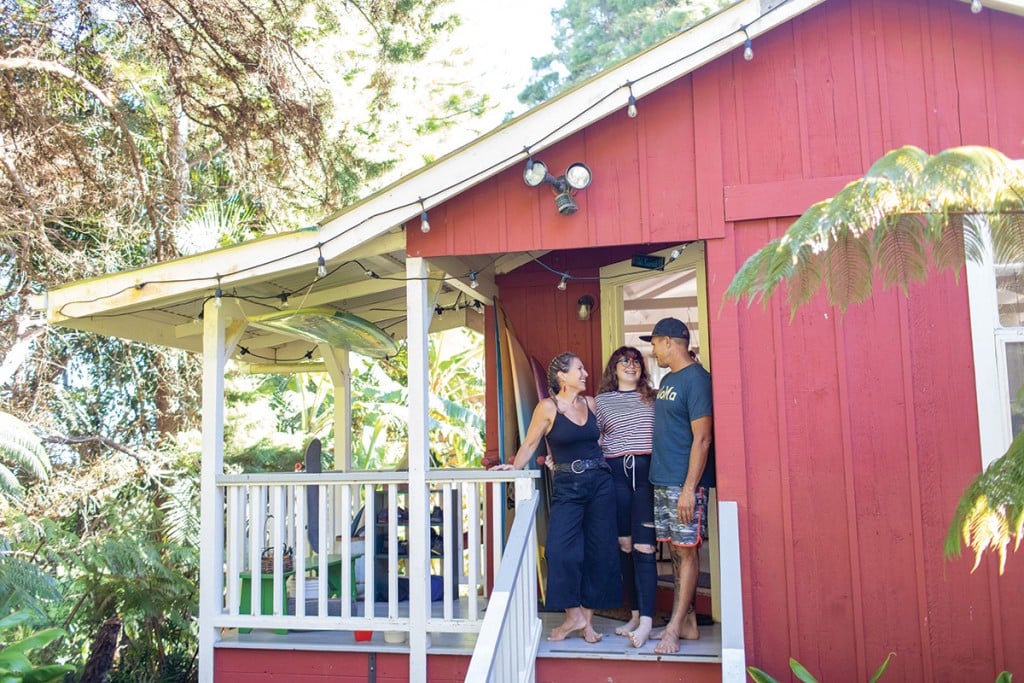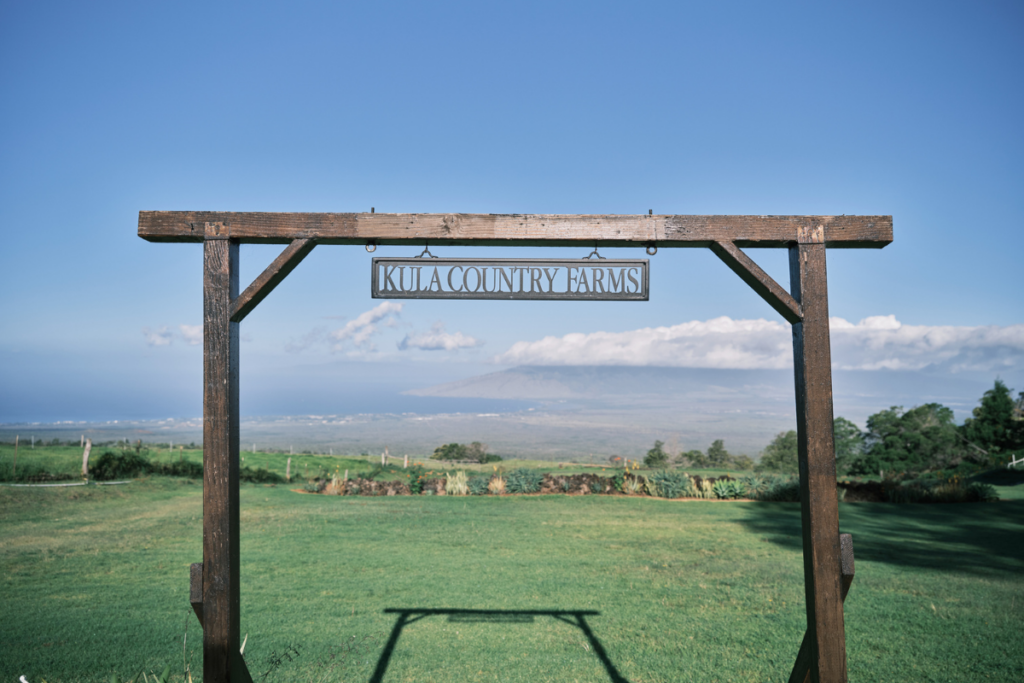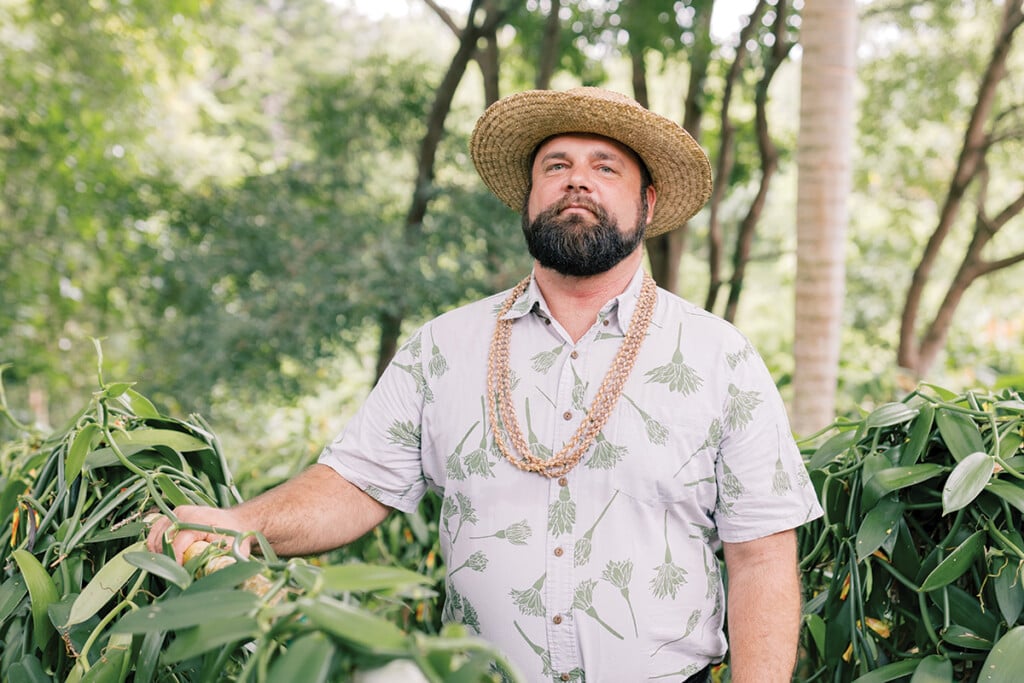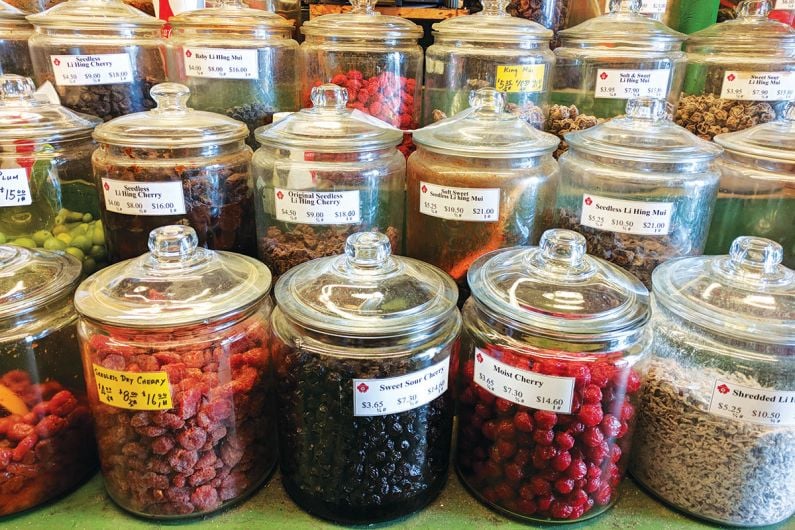Learn How This Big Island Family Found Artistic Inspiration in their Isolation
Keith Tallet and Sally Lundberg returned to Hawaii Island and found a source of creativity along the remote Hamakua Coast.

“Keith told me that he would never imagine living out here,” says artist and photographer Sally Lundberg. She says she’s 47, but, after a near life-time enjoying the ocean, emits youthful energy from the top of her sun-bleached hair to the bottom of her well-worn slippers. “This seemed like way [far] away.”
Her home, the Keolamauloa Homestead, is in Paauilo, which, even to people living on the remote northeast coast of Hawaii Island, is still considered “out there.” There’s a church, a post office, a school and not much else. Lundberg lives on the property with her husband and fellow artist, Keith Tallet, 50, who has the muscular physique of a firefighter and the bronze skin tone of a lifeguard, and their 15-year-old daughter, Kiai. And it’s here in Paauilo, an hour’s drive from Hilo, that Lundberg and Tallet decided to start their business, Mahiai Creative Studio, which sells handboards, jewelry and other boutique products, finding a wealth of inspiration and artistic ingenuity in their isolation.
Lundberg and Tallet are no strangers to country living, both born and raised on Hawaii Island. After attending Hilo’s St. Joseph School together and starting to date “sometime in our 20s,” says Lundberg, the couple moved to the Mainland to attend the San Francisco Art Institute. While there, they immersed themselves in the local art and surf scene. “We stuck out,” says Lundberg. “We’re really smiley people, tan, we had these really colorful surfboards. People there are very serious. They have black wetsuits and that’s it.” Today, the family can often be found in Waipio Valley, bodysurfing or thrifting in the nearby town of Honokaa on their days off.

Photo: Fletcher Photography
Back then, though, the two artists fit in perfectly in San Francisco, where they lived for eight years, earning degrees and working as artists in the city. But life loves curveballs. In a two-week stretch, Lundberg and Tallet found out they were to be evicted from their studio and that the San Francisco Art Institute’s school store, which Tallet managed, was closing. To top it all off, Lundberg was pregnant. “We were sitting in our room at the back of our house saying, ‘Wow, OK, change is upon us,’” says Lundberg. “I was not excited,” Tallet adds with a laugh.
After contemplating where they should settle down next—New York or Los Angeles—Lundberg’s mother asked her to come back home and help manage their 4-acre family homestead. “I realized I wanted our daughter to be born here in Hawaii,” says Lundberg. And although they were excited to come home, as artists, they were less thrilled about swapping the flourishing and hip community in San Francisco for the rural solitude of the Hamakua Coast. Fortunately, creativity finds a way—and sometimes that means making the most out of what you have.

Photo: Fletcher Photography
Moving back to Hawaii in 2004, they both found jobs as art teachers: Tallet works with disabled children and Lundberg teaches at Hawaii Preparatory Academy in Waimea. And although Tallet’s creative passion was dampened after moving away from the bustling art scene in San Francisco, it was quickly reignited after he began using a skill he’d learned from his father—shaping surfboards. “The material and the process—I knew that more than painting, which I have a master’s degree in. I was more comfortable [shaping boards] because it was easier using those materials to make art,” says Tallet, who grew up shaping his own surfboards as a keiki (kid). “I learned shaping from my dad and, at the time, it wasn’t fun. I always thought, ‘Man, when I grow up, I’m just going to buy my own boards.’” Ironically, it was this artistic spark that led to one of Mahiai Creative Studio’s first featured product lines: Manukai Handboards.
Inspiration initally struck Tallet and Lundberg as they watched bodysurfers gliding effortlessly on the waves at Point Panic, on Oahu’s South Shore. “We were looking at them, and I was like, ‘Oh my God, Keith, I want to try it, I want to try it,’” says Lundberg. Bodysurfers use only a small, thinly cut oval-shaped hand-plane strapped to one hand. “So Keith made me a handboard out of a piece of plywood,” says Lundberg. “I took it out at Waipio Valley, and it was so much fun. But eventually, the plywood just came apart.” After a process of fine-tuning and asking other local bodyboarders for feedback, Lundberg and Tallet realized that they could start making, and selling, handboards.
But they wanted to do it in a sustainable way.

Photo: Fletcher Photography
Starting with recycled foam from broken surfboards donated to the family by local surfers, Tallet went to work crafting colorfully designed—Lundberg calls it the “rainbow shave ice aesthetic”—handboards. Coming in all sizes, these oval-shaped planes are made with different types of waves in mind. The smaller, more refined Iwa model, for example, knifes into waves easier and works better in shore breaks where riders don’t have much time before waves collapse. The longer and thicker Nehu handboard, on the other hand, glides more efficiently on flatter waves and can be used to catch swells farther from shore. This isn’t just theory, either. Many of Manukai Handboards’ models are tested by local bodysurfers, who, in turn, give their feedback to Tallet, giving him more ideas for new boards. “That’s the hard part about being an artist—you always want to keep experimenting,” says Tallet. “And I’m the one doing the selling,” replies Lundberg, “so I have to keep reminding him we have to have a good supply of our standard models.”
Tallet also started using natural, sustainable resources like agave and koa wood found in the gulch near their Paauilo homestead as a base for his boards. In a small art studio that Tallet uses for his surfboard shaping, stacks of shipping foam Tallet found in a dumpster are piled six feet high and are now being used as the foundation for ultra-light handboards. “Being out here really helped me think about things in my own way. And I feel you have to be a lot more resourceful when you’re all the way out here,” says Tallet. “If you see the surf world now, they’re all using crazy eco-friendly materials to shape boards, and I think if you go further away from cities to the more isolated corners of the world, people have been doing that for a while.”
Tallet and Lundberg’s property, however, has never made isolation look so idyllic. Their land is large, and the family uses the space well. One large storage shed is full of recycled boards and in front of that sits a pen where a massive pig grunts happily in its muddy bed. Mamaki, avocado trees and koa grow on their sprawling lawn and even more broken surfboards rest in a crawl space under their art studio. How many boards do they have in total? “Quite a bit,” answers Keith, unsure of the exact number. A black cat named Aka dozes on the studio’s steps. Keith calls him Troublemaker, since he once knocked over a finished surfboard and broke its tail. (The board’s, not the cat’s.)

Photo: Fletcher Photography
In the same studio space, which overlooks even more of the homestead’s native Hawaiian forest that was started by Lundberg’s mother and out to sea, Lundberg has a space to craft handboard bags from recycled wetsuits. It’s also here that Lundberg designs Mahiai Creative Studio’s line of jewelry, Kalakoa Designs, creating earrings and oversized rings from leftover resin from glassing handboards. They sell the jewelry online. “That’s the amazing thing about our present. We can put ourselves out there as artists and sell things even though we live all the way out here,” says Lundberg.
Looking out over the rolling green expanse of their property, Tallet reminisces on what was going through his mind as he was leaving the thriving San Francisco art scene for the remote, disconnected coast of Hamakua. “At first I figured, ‘Man, I’m going to move to Hawaii and my creativity is going to suck.’ But really, being further away from all of the other artistic influences, you can kind of just be yourself out here,” says Tallet. “We’re definitely aware of what’s going on in the art scene, but being out here gives it that buffer, and that has had a huge impact on our artwork,” adds Lundberg. “We wouldn’t be making what we’re making now.”
To see what products Mahiai Creative Studio has in stock, call (808) 345-7047 or visit mahiaicreative.com.


